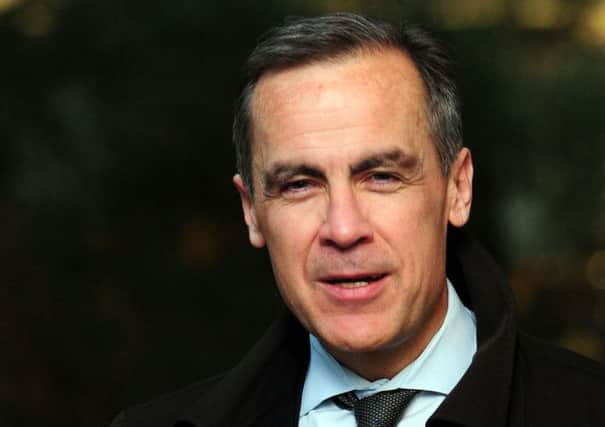Bill Jamieson: Only way is up for interest rates


There was also “more spare capacity in the labour market than we previously had thought”.
Earlier this month he caught City analysts off guard when he told the Mansion House dinner that interest rates could rise “sooner than markets presently expect”. That prompted traders to pull forward their bets on the first rate rise to the autumn, having previously pencilled it in for the first quarter of 2015.
Advertisement
Hide AdAdvertisement
Hide AdThroughout have been assurances that rate rises would be modest and gradual. But last Friday he told the BBC Radio 4’s Today programme that rates could reach 2.5 per cent in early 2017.
Circumspection is a wisdom yet to be acquired by this central bank governor. A year ago he promised that a new regime of “forward guidance” would bring greater long-term predictability and transparency to rate setting and enable households and business to better plan their affairs. That regime has now collapsed and been replaced by a series of ad hoc musings and pronouncements. Confusing? Contradictory? Conjectural? All of these.
The result is that for anyone taking out a mortgage today, or planning business investment or expansion, we are little the wiser as to what the level of interest rates will be six months from now, never mind two years.
However, there is a wisdom being revealed here, however clumsily. “The big picture,” he said “is not whether the bank rate goes from 0.5 per cent to slightly above that lowest ever level.
“The big picture is where interest rates go in the medium term, because if I am taking out a mortgage and if I am thinking of investing in a new plant, if I’m thinking about taking on new people. That’s what I’m thinking about.”
Well, quite. It may well be that a return to the “old normal” of interest rates at around 5 per cent is unlikely. But there is nothing normal about official interest rates rising five-fold in less than three years, which is what his latest prediction implies – assuming that this one is not overtaken by events, as his previous predictions have been.
And the problem with his indication of a “new normal” of 2.5 per cent is that markets are wont to turn such forecasts very rapidly into fact. If that is to be the official “new normal”, it’s likely to arrive sooner than we think.
Mark Carney’s conflicting statements are an earnest attempt to reconcile two contradictory but equally dangerous threats to the economy. The first is the need to remove the crutch of ultra-low emergency interest rates before a genuine UK-wide housing bubble takes hold and without causing the upturn to stumble and relapse.
Advertisement
Hide AdAdvertisement
Hide AdThere is still under-utilised capacity in the economy. And average earnings have not, or not yet, responded in the manner of previous recoveries: wage rises, where they have been evident at all, have been subdued, putting a question mark over the solidity of demand for skilled labour. Meanwhile, the prospect of higher interest rates later this year has already sent sterling higher and could curb business investment and the appetite for bank finance when these have barely yet begun to recover.
The second threat poses no less a danger. This is that households, hugely over-borrowed by previous standards, may find themselves in financial stress when rates do start to rise and those higher monthly mortgage outgoings bite into already stretched family budgets.
For example, the monthly outgoings on a 25-year £150,000 variable rate capital and interest repayment mortgage at today’s rate of 3.9 per cent costs around £784 a month. A rise to 5.5 per cent would take this to £921. And at 6.5 per cent – close to the full 3 percentage point rise that borrowers will now need to satisfy lenders that they could cope with – the cost would rise to £1,050, or some £266 more a month. Breadwinners would need to see a hefty increase in their after-tax earnings to cover this.
Little wonder Mr Carney frets over the preparedness of households for such an outcome. There may be little prospect of a return to the “old normal” of interest rates at 5 per cent because household debt has fundamentally changed and risen radically from previous levels. But interest rate movements from today’s 0.5 per cent level are likely to have a much bigger impact on household spending than in the past.
The governor’s statements have been accompanied by plans to cap riskier mortgage lending amid fears of a housing bubble. The Bank has indicated that lenders will not be allowed to lend any more than 15 per cent of residential mortgages at more than 4.5 times a borrower’s income. According to the Council of Mortgage Lenders, around 9 per cent of new loans across the UK are at 4.5 times income or more, with this figure shooting to 19 per cent in London, which is certainly in “bubble” terrain.
And lenders will also have to check that mortgage applicants can cope with a 3 percentage point rise in interest rates – slightly tougher than current affordability checks.
What’s clear beyond doubt is that we are being prepared for an end to a remarkable five-year reign of ultra-low interest rates and that households and businesses alike need to prepare. What Mr Carney’s contradictory outpourings amount to is this: the first rate hike to 1 per cent may well come before the end of this year. And further rises are set to follow to a “best guess” of 2.5 per cent over the next two years. But stand by for changes: that’s just the view from Threadneedle Street for now. «